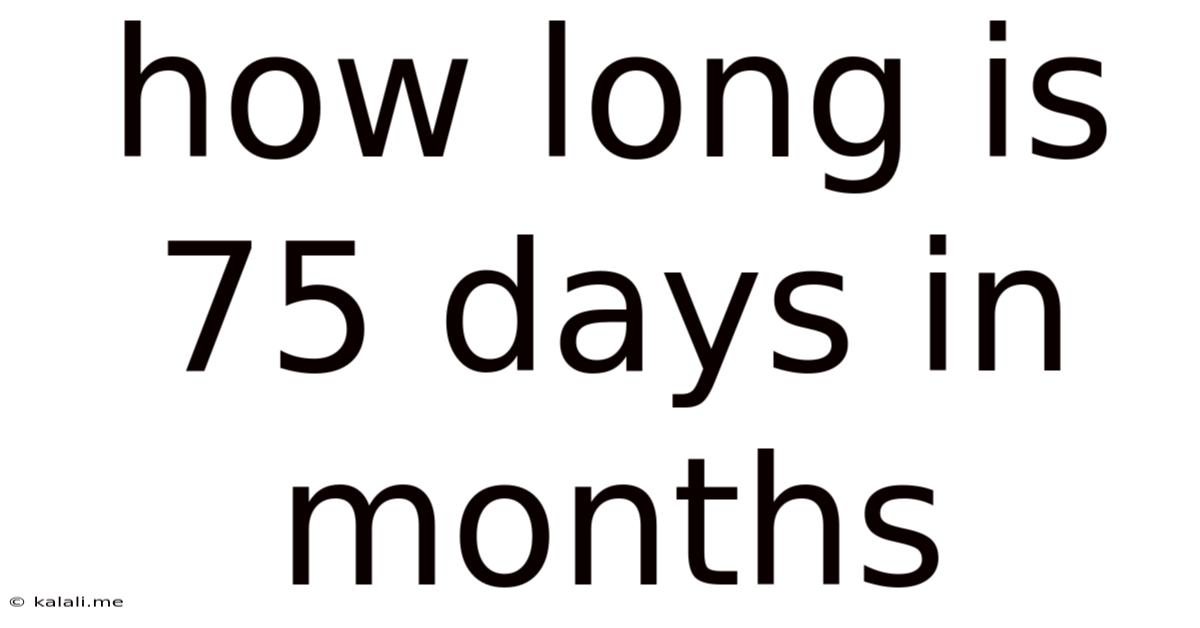How Long Is 75 Days In Months
Kalali
Jul 14, 2025 · 4 min read

Table of Contents
How Long is 75 Days in Months? A Comprehensive Guide to Time Conversions
Knowing how to convert units of time is a crucial skill, whether you're planning a vacation, tracking project deadlines, or simply understanding the passage of time. This article dives deep into the question: how long is 75 days in months? We'll not only provide the answer but also explore the complexities involved, different calculation methods, and provide practical applications of this knowledge. This comprehensive guide will equip you with the tools to confidently handle similar time conversions in the future.
Understanding the Challenges of Converting Days to Months
Unlike converting between units like centimeters and meters where a simple multiplication or division suffices, converting days to months presents a unique challenge. This is because months are not of uniform length. A month can have 28, 29, 30, or 31 days, depending on the specific month and whether it's a leap year. This variability makes a direct conversion impossible without making assumptions.
Approaches to Calculating 75 Days in Months
We'll explore several approaches, each with its own level of accuracy and applicability:
1. The Average Month Approach
The simplest approach is to use the average length of a month. While not perfectly accurate, it provides a quick estimate. An average month has approximately 30.44 days (365.25 days in a year / 12 months).
To calculate 75 days in months using this method:
75 days / 30.44 days/month ≈ 2.46 months
This means 75 days is approximately 2.46 months using the average month calculation. This is a useful approximation for general estimations.
2. The Specific Month Approach (Requires More Information)
For a more precise conversion, you need to specify the starting date. Knowing the starting date allows us to count the exact number of months and days encompassed within the 75-day period. For example:
- Starting on January 1st: 75 days from January 1st would extend into March, with a remainder of a few days. The exact number of months and remaining days would depend on whether it is a leap year.
- Starting on June 1st: 75 days from June 1st would fall in August, again with a remainder of some days.
This approach is significantly more accurate but demands context. Without specifying a starting date, any conversion will only be an estimation.
3. Considering Leap Years: A Crucial Detail
The presence of a leap year significantly impacts the accuracy of any calculation. Leap years occur every four years (except for years divisible by 100 but not by 400), adding an extra day (February 29th) to the calendar. This extra day affects the total number of days in a year and, consequently, the average length of a month. Ignoring leap years can lead to minor inaccuracies in long-term calculations.
Practical Applications of 75-Day Conversions
Understanding how to convert 75 days into months has numerous practical applications across various domains:
-
Project Management: Project managers frequently use time units to track milestones and deadlines. Knowing that a 75-day project is roughly 2.5 months helps with better planning and resource allocation. This allows for more accurate budgeting and forecasting.
-
Financial Planning: Calculating interest or loan repayments often involves time conversions. Understanding the timeframe (approximately 2.5 months) can facilitate accurate financial calculations.
-
Event Planning: Planning events, especially those spanning several months, requires accurate time estimations. Converting 75 days into months provides a clearer picture of the event's timeframe.
-
Personal Time Management: Whether it's tracking a personal goal, planning a trip, or managing personal deadlines, converting days to months offers a broader perspective on the time involved.
-
Scientific Research: In scientific studies involving durations, accurate time conversions are essential for data analysis and reporting. 75 days could represent a significant timeframe in many biological or ecological studies.
Beyond Simple Conversions: Working with Calendar Systems
The complexities of converting days to months highlight the intricacies of calendar systems. Different cultures and historical periods have used various calendar systems, each with its own unique structure and conventions. Understanding these nuances is essential for accurate historical research or work involving international collaborations.
Advanced Time Conversion Techniques
For more complex scenarios involving multiple units of time (days, weeks, months, years), specialized software or programming tools can be used. These tools often incorporate algorithms that account for leap years and the varying lengths of months, providing precise conversions.
Conclusion: Mastering Time Conversions
Converting 75 days to months doesn't yield a single definitive answer. The accuracy depends on the approach used and the context provided. While the average month approach gives a quick estimate (approximately 2.46 months), a more precise calculation requires specifying a starting date and considering leap years. Understanding the limitations and nuances of time conversions is vital for accurate planning, scheduling, and financial management across various fields. The more information you have, the more accurate your conversion will be. Remember to always consider the specific context to ensure accuracy and avoid potential pitfalls.
Latest Posts
Latest Posts
-
How Many 1 8 Are In 1 4
Jul 14, 2025
-
Numbers That Add Up To 25 With 4
Jul 14, 2025
-
How Many Bones Does A 7 Year Old Have
Jul 14, 2025
-
States With The Letter Y In It
Jul 14, 2025
-
Ocean Beaches Within 8 Hours Of Ohio
Jul 14, 2025
Related Post
Thank you for visiting our website which covers about How Long Is 75 Days In Months . We hope the information provided has been useful to you. Feel free to contact us if you have any questions or need further assistance. See you next time and don't miss to bookmark.